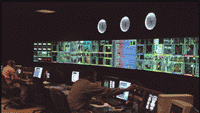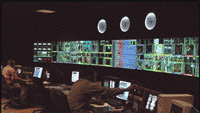Starz Encore automates with OmniBus' Colossus


Operators at Starz Encore’s broadcast operations center monitor 26 primary channels and 26 backup channels using the Omnibus Colossus automation system.
When the Starz Encore Group, a U.S. provider of cable- and satellite-delivered premium movie channels, moved to a new purpose-built facility in Denver, CO, it decided to replace its existing tape-based system with a server-based operation.
This transition demanded a solution that met specific operational requirements, while also providing the scalability needed for future expansion. It needed an automation system that could control all its primary channels – including time-zone variations – as individual schedules in real time while offering full parallel backup of all streams and preview channels. The solution also had to move material between servers, accommodate the transfer of material from the data tape archive system into the servers, and allow extra channels to be added at little extra cost.
The group commissioned OmniBus Systems to provide the technology to handle not just the movie playout but also the ingest process, asset and media management, and the movement of material around the facility. OmniBus’ Colossus – a multichannel, multiformat content delivery and control system – provides a timeline-based display that allows the operator to monitor the status of multiple channels, focus in on any single stream and quickly identify any specific problems in terms of missing media or failed devices.
A single Colossus system handles a total of 52 channels (26 primary channels and 26 backup channels) and can accommodate the East and West Coast feeds of all Starz Encore’s primary channels. This master-control operation is manned 24 hours a day by a team of three: two master control operators and one supervisor.
At its previous facility, Starz Encore contracted its playout operations through a separate company. With the relocation, the group brought the operation in-house, resulting in a savings of millions of dollars. In addition to controlling movie and interstitial playout, the system also controls Pinnacle MediaStream 700 and 1600 servers for media acquisition, global asset and media management (GAMMA), and the system infrastructure.
One of the challenges the group faces is the sheer amount of material the master control operators have to process. One screen of the automation system’s user interface accommodates a large number of channels, giving the operator a quick idea of what’s going on, where the next break is coming up and what’s happening on the system. (See Figure 1.)
Get the TV Tech Newsletter
The professional video industry's #1 source for news, trends and product and tech information. Sign up below.
Figure 1. The user interface of the Colossus enables Starz operators to keep up with a large number of channels by providing a quick overview of what’s going on at any given time.
Much of the quality-control process, which was previously carried out manually, is now under the system’s control, allowing operators to capture information to be fed directly into the traffic system.
The integration between the two systems is proving beneficial. Starz Encore generates an electronic form to list all films that have been registered. Embedded within this form, Colossus provides desktop video-server control and the ability to log any errors. If the operator notices any defects, he can fail the film and it will be rejected. If this occurs, the system deletes the registered information from its database. Once the operator has successfully checked a film for quality, the Starz system assigns unique reel numbers to each of the tapes in the data archive on which it resides.
The electronic registration database passes the new reel numbers for the master and protection copies to the automation system, which then changes the film name and locations to match the newly assigned reel numbers in its database.
Starz runs almost two hours of interstitial material on each channel every day. Editors produce the material for the interstitial reels in the facility’s nonlinear edit bays and then register the individual clips with the system. The traffic system provides the Colossus with minischedules that contain content and caption requirements for each channel’s interstitial blocks. The automation system then automatically plays the reels, adds captioning and mixing as required, and records the output, which is then included as a single completed item in the channels’ schedules. This unique approach satisfies the facility’s multichannel requirements with minimal technical equipment and reduced operator involvement.
Screening of the interstitial material used to be a time-consuming process. Using the preview functionality developed for the facility, operators can now call up any of the material on a monitor and view the final 10 seconds of the outgoing item and the first 10 seconds of the incoming piece, allowing them to scan through all the breaks quickly to check for errors.
Operators use the system’s Transfer Manager to control the flow of material from the archive system into the servers for playout. This allows Starz to monitor the status of the network, a big concern given the amount of material that moves across each of its channels every day.
Lastly, the system’s Cache Manager allows users to monitor and manage the amount of free storage capacity on the broadcast servers, another area in which Starz hopes to substantially reduce its investment without affecting operational efficiency.
Ray Milius is vice president of production and operations at Starz Encore Group.
